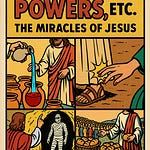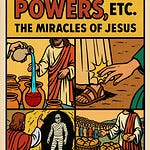I concluded our Lenten sermon series on the Sorrows of Mary by preaching on John 19.18-30.
At the beginning of Russia’s invasion of Ukraine three years ago, just before Palm Sunday, at the United Nations Security Council meeting, representatives from the Ukrainian Security Service presented text messages they had captured from the smartphones of Russian soldiers killed in action. In one thread, a soldier had written to his mother, describing how Vladimir Putin’s invading army is “hitting everyone, even civilians.” The soldier continues, informing his mother that he is no longer in Crimea doing training exercises, as she had been told by her government.
When his mother responded in the thread by asking if she can send her boy a care package, he replied, “Mother, the only thing I want now is to hang myself...this is real war, mom. I’m scared. I’m so scared, we’re hitting everyone, even civilians— women and children even. We had been told that people would welcome us here but they jump under our vehicles, not letting us pass. They call us fascists. Mom, it’s so hard.”
Finally enthroned upon his cross, this Mother’s son is neither frightened nor overwhelmed. Throughout the Fourth Gospel Jesus has spoken of his passion as the hour to which his path inexorably led. At the Passover, between noon and three— this is the hour to which he has been headed from the beginning.
On purpose!
Not as the passive casualty of empire.
If his passion is not harrowing for him, then it is a torment for her.
Indeed it must have taken great faith bordering on delusion to see in his crucified body the one of whom she sang at the Annunciation. One ancient icon of the church titles the pregnant Mary, “Container of the Uncontainable.” At the foot of his cross, the Container of the Uncontainable bears the unbearable. In fact, at Golgotha Mary’s hour arrives as well. As her son teaches the disciples on Holy Thursday, “Truly, truly, I say to you, you will weep and lament, but the world will rejoice; you will be sorrowful, but your sorrow will turn to joy. When the woman is in travail she has sorrow because her hour has come.”
“Son, it’s so hard.”
Hollis Gause was a Pentecostal theologian who died a decade ago. He wrote a meditation on Mary’s experience at the foot of the cross. In it, he imagines Mary looking up at her dying child, realizing, with a start, that this boy, born all those years ago in disgrace and ignominy, now is dying under an even darker sky.
Right in that moment, Gause suggests, Mary feels the stab of pain:
“Now the final words of Simeon’s prophecy rushed through her heart like a dagger, “A sword shall pierce your soul.” Mary thought, “Now I know what those words mean. Every nail in His hands and feet was driven into my heart, and it bleeds as profusely as His hands and feet. Is this the way that the thoughts of many hearts will be revealed? Are these nails the scalpels that lay back the tissues of the heart exposing the innermost thoughts? They certainly expose the hearts of our rulers… Corruption pours out of them like the blood out of my Son.”
If Rome’s nails are the scalpels that peel away the tissues of our hearts, if the sword prophesied by Simeon has finally pierced Mary’s heart, then Christ’s own heart belies his frightful appearance.
Enthroned upon his cross, Christ does not sorrow; he proclaims, “Woman, behold thy son!”
Behold.
In a New Yorker article entitled “The Woman Behind the Camera at Abu Ghraib,” Errol Morris probes the atrocities committed by American soldiers in Iraq. “Of course,” he writes, “the dominant symbol of Western civilization is the figure of a nearly naked man, tortured to death — or, more simply, the torture implement itself, the cross. But our pictures of the savage death of Jesus are the product of religious imagination and idealization. In reality, he must have been ghastly to behold.”
“Woman, behold your son.”
Errol Morris’ essay continues, “Had there been cameras at Calvary, would twenty centuries of believers have been moved to hang photographs of the scene on their altarpieces and in their homes?”
I think not.
Certainly not his mother.
“He must have been ghastly to behold.”
Errol Morris writes better than Jesus can manage to utter, his chest pulled taut by his cross. Morris saves the most important verb for the end of his sentence, “He must have been ghastly to behold.” The word appears nearly thirteen hundred times in the scriptures. As Fleming Rutledge comments on the now antiquated biblical word, “When the word translated “behold” appears in the Old and New Testaments it does not simply mean “see” or “look,” contrary to recent translations. It denotes a powerful revelation leading to understanding, insight, and faith.”
Just so:
Exactly what does the Son unveil to his Mother from his cross?
To what precisely does he summon her to see by faith?
In the Gospel of John, Jesus only ever addresses his Mother as “Woman.”
As though, says the church father Origen, she is the Woman.
A New Eve.
“Daughter of thy Son,” Dante writes.
“Woman, behold, thy son! Behold, thy Mother! ”
No matter how her son addresses her, what does he wish her to grasp by beholding him on his cross? And what does he mean to unveil to us?
Surely what John does not intend us to see is Jesus spending his last moments minding after Mary. As Stanley Hauerwas writes, this word from the cross is not “simply an example of a son’s solicitude for his mother’s welfare.” Nor should we expect to see anything so ordinary as Jesus securing care for Mary. Everything in the Gospel of John is pregnant with theological meaning. What’s more— notice— we are bidden by the LORD to behold not only him but also her and, in beholding the both of them, truly see.
But see what exactly?
Frank Dunham was a career prosecutor and defense attorney in Washington before becoming the federal public defender for the Eastern District of Virginia in 2001. Frank argued the habeas corpus case of Yasser Hamdi before the Supreme Court against the Bush administration in 2004. In the summer of 2006, Frank's wife, Eleanor, wandered into my office one morning.
“I was in the sanctuary,” she said, as though I needed some explanation.
“I was in the sanctuary praying. I've never done that before. I've never done this before,” she said.
Ellie was in the church database, but I'd never seen her in worship before. After hemming and hawing, she finally opened up about why she had been praying in an empty sanctuary on a Tuesday morning. Her husband, Frank, just sixty-four years old, was dying of brain cancer.
“I'm afraid he's in denial. I think we're all in denial,” she told me.
And then she asked me, “Would you go by the house and talk to him? Is that something you do? Frank's got that look he gets during a trial when he's afraid he's going to lose the case.”
The first time I visited Frank he was still strong enough to greet me at the front door and reluctantly gesture me into the house like I was the Schwann's salesman.
As I followed him into the kitchen, Frank offered up a disclaimer, “I’ve not been a very good member of the flock, preacher. I figured there wasn't much to Christianity other than a community I didn't need, trite sermons I couldn't stomach, and activities I didn't have any time for. By all means, I’m good with the Golden Rule, but I could never get too serious about a religion that begins with a fantasy. I mean, a miraculous virgin birth— are you effing kidding me? ”
He looked over his shoulder to see if his words would cause me to scurry.
I smiled.
Nodding, he gestured for me to sit down at his kitchen table.
“You know,” I replied, “There's more to Christianity than the moralisms you learned as a kid in Sunday school."
He laughed like he did not believe me at all.
So I tried a different angle.
“Besides,” I added, “the Virgin Birth does not mean Mary conceives Jesus apart from Joseph.”
“It doesn’t?” he put his paper down and laid his reading glasses on page A3.
“Of course not,” I said, “That would be a stupid reason to include it in the creeds.”
“If this is evangelism, you’ve got a funny way of going about it.”
And then he waited for me to elaborate.
“The doctrine of the Virgin Birth is not about sex,” I said, “It’s about blood.”
He squinted at me.
“Blood? I don’t understand.”
“The dogma is not merely that Mary was a virgin when she conceived Jesus,” I explained, “The dogma— the orthodox teaching— is that Mary remained a virgin even after delivering Jesus; that is, she gave birth without any issue of blood.”
He folded his arms across his chest and raised an eyebrow at me, “If you’re trying to make me into a believer, you’re sort of working me in the opposite direction.”
I laughed.
“Out of curiosity,” he continued, “Why is that so important?”
“You really don’t remember your Sunday School, do you? It goes back to King David. Remember, he was not permitted to build the temple in Jerusalem. God did not allow David to construct the temple because of Uriah. Which is to say, the LORD refuses to have his temple through the shedding of blood.”
“What’s that have to do with Jesus and Mary?”
“Since Jesus is God,” I answered him, “Mary is the temple, thus her virginity.”
He beheld me over the bridge of his reading glasses.
I met his gaze.
“If you’re not going to be a believer, Frank, then you ought at least know that the church is daring you to reject a great deal more than you realize.”
He smiled a reluctant grin.
“I know I’m dying,” he said, “I’m not in denial, even if Ellie fears I am.”
I nodded.
“So,” he said, “You’ve got limited time to persuade this juror, and since you don’t appear all that adept at evangelism you’re going to need as many cracks at it as you can get. Come again anytime.”
Just as his Mother is the virgin temple, so too does Jesus repeatedly insist that the flesh he receives from Mary is the Container of the Uncontainable. Almost a dozen times in the Gospel of John he points to the temple so as to gesture to himself. Just after the wedding at Cana, Jesus cleanses the temple in Jerusalem. And when those gathered there ask him what the performance of this sign signifies, Jesus answers by speaking of a different temple, “Destroy this temple, and in three days I will raise it up.”
Like his Mother’s womb, his flesh is the dwelling place of God on earth.
And like the Virgin Mary, Jesus has at last arrived at his hour without the shedding of blood.
From Cana to Calvary, he has loved his enemies and turned the other cheek. From his cross even, he pleads the Father’s forgiveness for those who know precisely how they are trespassing him. In the Garden of Gethsemane, at the precipice of his passion, when Peter draws a sword to strike Caiphas’ soldier, Jesus rebukes Peter, “Put your sword into its sheath; shall I not drink the cup that the Father has given me.” From the beginning, the New Adam, the son of the Second Eve, has embodied and born witness to the peaceable Kingdom of God. As he promised to John the Baptist in the Jordan River, Jesus has fulfilled all righteousness.
And now, enthroned upon his cross and breathing his last— obedient to the end, Jesus bids us to behold the completion of the LORD’s temple on earth.
He has built it without shedding another’s blood.
Scripturally speaking—
The Son is as much a virgin as his Mother.
The temple that is his body is not the only beholding to which the Bible bids us, for the flesh Mary gives him he takes to the heavenly tabernacle where he presents it to the Father enthroned there. As the church father Gregory of Nazianzus preached, “Even at this moment, as a human being, Jesus is making intercession for my salvation, for he continues to wear the body that he assumed.”
Despite what Christ declares from his cross, it is not finished.
His work is not done.
Indeed it is perpetual.
As the Letter to the Hebrews proclaims, “Christ has entered, not into holy places made with hands, which are copies of the true things, but into heaven itself, now to appear in the presence of God on our behalf.”
Again the epistle declares that Jesus “being made perfect, became the source of eternal salvation to all who obey him, being designated by God a high priest after the order of Melchizedek.”
Notice:
Jesus is the source of salvation not on the basis of his cross.
Jesus is the source of salvation on the basis of his priesthood.
Salvation is not a past act.
Salvation is present-tense.
Jesus is saving you.
Or as Paul puts it in chapter four of Hebrews, “Since then we have a great high priest who has passed through the heavens, Jesus, the Son of God, let us hold fast our confession. For we do not have a high priest who is unable to sympathize with our weaknesses, but one who in every respect has been tempted as we are, yet without sin. Therefore, let us with confidence draw near to the throne of grace, that we may receive mercy and find grace to help in time of need.”
As New Testament scholar David Moffitt writes:
“The atoning work that Jesus continues to perform now is that of maintaining the new covenant relationship between God and his people, work that is necessary while the covenant people are still in the process of being sanctified and have not yet been perfected…As our high priest of the new covenant, Jesus now ministers in the heavenly temple by offering to the Father the ongoing worship that maintains God’s new covenant relationship with his people and mediates the blessings and promises associated with that relationship.”
In other words, the divine filiation in verse twenty-six of this passage is made possible only because Jesus is our great high priest. Mary is our Mother, the Beloved Disciple is our brother, only on the basis of the new covenant which Christ even now mediates on our behalf.
Quite simply:
What we behold upon the cross, the perfect faithfulness of the Son, is no use to us at all— it is not finished— if he is not raised to present his “indestructible life” to the Father in heaven’s holy of holies.
David Moffitt continues:
“Because Jesus ascended into the heavenly holy of holies and remains there, it follows for the Letter to the Hebrews that Jesus is the high priest who can guarantee that the new covenant relationship is perpetually maintained, something no earthly high priest could do because of death and because the law never brought about perfection. Because Jesus lives with death behind him, he is always able to intercede for his people and so is able to save them…The logic of Hebrews implies that if Jesus were not actively interceding for his people, their salvation would not be possible. Yet this implication suggests another: Jesus’ followers need ongoing atonement. The very work that the high priests on earth could do only once a year is done now by Jesus continually.
Because he is resurrected, Jesus is able to serve as our intercessor without interruption.”
It is not finished.
The sacrifice is not complete, until the risen Jesus offers his own indestructible life to the Father in the heavenly tabernacle on your behalf.
And he does it not once but day after day after day.
Until the end of days.
For you.
Behold!
Frank's memory faded as the tumor pressed against his brain. So each time I visited him before he died, we had some version of our first conversation. Every time he insisted he could not buy into a faith that began with a fantasy like the Virgin Birth.The second time I visited Frank I found his kitchen table saddled with newspapers. The way the Post and the Times lay open underneath his coffee mug I could tell he had been studying the stories about the trial of Zacarias Moussaoui, the only defendant charged in the attacks on September 11th. And that's when Frank told me how he had been Moussaoui’s lead defense lawyer until he'd become too ill to continue. From there, Frank went on to share with me the highlights from his resume. It was clear that now he was nearing the end of his life, he was coming up against the question of whether his life, the sum of it, justified him.
Frank stood up from the kitchen table and, in his bathrobe and slippers, shuffled over to a framed picture on the wall. It was a courtroom artist's rendering of Frank in court during a case. Frank in chalk or colored pencils standing before a judge. He pointed to it like the image could be the dust jacket for his entire life story.
“When I get to the pearly gates, will it be enough?” he asked me, “The good I've done— tried to do. Is it enough?”
“Of course it’s not enough.”
He pushed his glasses up his nose and squinted at me.
“Did it ever occur to you,” he asked, “That maybe your personality is better suited for a different line of work?”
“It occurs to me every damn day,” I said, “But that’s precisely my point. It’s not a question of whether or not we’re enough. We need to be made perfect.”
“Well, I’m about out of time for self-improvement,” Frank replied, “The gavel’s about to come down on me.”
“Then it’s a good thing it’s not your work at all, Frank”
He turned to me like I was a witness whose testimony had suddenly veered off course.
“Exactly what makes Mary a virgin is what qualifies Jesus to be your intercessor. You’re an attorney, Frank. Just think of it— in Christ you have an Advocate whose defense of you will never rest.”
“I reckon that would be a good thing.”
“No,” I replied, “Not a good thing; it’s the good news.”
“Still,” he hedged, “When it comes to faith, I’m a hung jury. I don’t know that I can believe.”
“Why don’t we let Jesus take care of that?” I said, “I’m just an inept evangelist, remember? He’s your high priest. And his work is not finished until he comes again.”
Maybe it's because his memory finally faded. But I like to think it's because the gospel finally clicked for him. Frank never after asked me about the pearly gates nor did he ever protest that our faith begins with a fantasy.
Behold:
Loaf and cup.
Not only does Jesus rise to present his indestructible life to the Father for you, he erupts from the grave in order to distribute his undestroyable self to you, for you, in bread and wine. This is no more a “Catholic” doctrine than his Mother’s perpetual virginity— it is orthodoxy.
He is more than your pardon.
He is your perfection.
He is more than your salvation.
He is your sanctification.
He is NOW making you more than you can see or imagine.
Don’t believe me? Doubt?
That’s okay, because he who is your Perfection is also your Priest.
So come to his Table.
That I can so bid you is proof— or, as Frank would have it, evidence— that Christ’s work is not finished.
It is perpetual.
It is continual.
It is today.
Come to the table, taste and see.
And bring his work closer to completion.
Because in the End, Christ will say of you, “Behold!”













